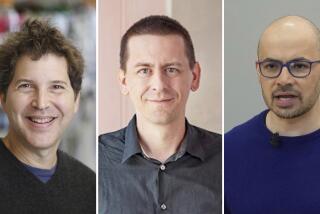3 Americans win Nobel in physics
One scientist set the stage for the globe-girdling fiber-optic networks that transmit the bulk of everyday television, telephone and other communications. Two other scientists developed the electronic eye that makes digital photography possible. On Tuesday, all three -- described as “masters of light” -- were awarded the 2009 Nobel Prize in physics.
Charles K. Kao, a naturalized American who did most of his work in Britain and Hong Kong, will share half of the $1.4-million prize for demonstrating that highly purified fibers of glass can carry light waves for long distances. Willard S. Boyle and George E. Smith, also Americans, will share the other half for developing the charge-coupled device, or CCD, which in less than two decades has filled the world with inexpensive digital cameras and camera-equipped cellphones.
The announcement was greeted with acclaim for the impact the men have had on the lives of average people the world over.
Fiber-optic communication “is essential for high-speed Internet and forms the optical backbone of 21st century commerce,” said H. Frederick Dylla, executive director of the American Institute of Physics. “The CCD sensor has revolutionized technical, professional and consumer photography in the last few decades. Taken together, these inventions may have had a greater impact on humanity than any others in the last half-century.”
Humans had known for more than 4,000 years that glass could transmit light, but the process was inefficient. When researchers developed the first optical instruments to look inside mechanical equipment and the human body, they used bundles of glass fibers. These crude devices leaked light from one fiber to surrounding fibers, impairing efficiency and the integrity of images.
That problem was partially solved by the 1940s by coating each fiber with glass of a slightly different refractive index, which reflected light back into the fiber. Nonetheless, after only about 60 feet, most of the light had been lost.
In the late 1960s, Kao, who was then a young scientist at Standard Telecommunications Laboratories in Britain, began studying such fibers with the goal of having 1% of the light remain after a distance of 0.6 miles (one kilometer). Although other scientists thought that transmission losses were caused by imperfections in the crystal structure of the glass, Kao decided that it was caused by fiber impurities absorbing light. He concluded, theoretically, that a highly purified fused quartz glass would be much more efficient.
In 1971, technicians at Corning Glass Works in Corning, N.Y., used his ideas to produce the first long, ultra-thin glass fiber. Today, after further refinements, such fibers retain 95% of light after 0.6 miles, a remarkable achievement. Such fibers, moreover, are strong, lightweight and flexible.
In 1988, the first optical-fiber cable was laid beneath the Atlantic Ocean, capable of carrying tens of thousands of times more information than the metal cables it replaced. Today, more than 600 million miles of optical fiber have been laid.
Boyle and Smith didn’t set out to revolutionize photography. As researchers at Bell Laboratories in New Jersey 40 years ago, they were looking for a better memory device for computers. To build one, they took advantage of the photoelectric effect that won Albert Einstein a Nobel in 1921. In short, when light hits a small piece of silicon, it knocks electrons out of their orbits; if the silicon has been formed into small photocells, or pixels, each cell acts as a well that captures and holds the electrons for an extended period.
The men devised a way to read out the number and location of electrons captured in each well in an array of photocells. In a 10-by-10 array, for example, the data are transformed into a chain of electron concentrations 100 pixels long. This can be converted back into information.
Within a year, in 1970, Boyle and Smith had given up on their memory device and produced a digital video camera. Two years later, Fairchild Semiconductor of San Jose constructed a camera with a (small by modern standards) 100-pixel-by-100-pixel photo sensor (10,000 pixels), which entered production a few years later. By 1975, the Bell duo had constructed a digital video camera suitable for television.
In 1986, the first 1.4-megapixel camera was produced. Today, sensors exceeding 100 megapixels are available, and they have uses not only in photography, but also as sensitive detectors in telescopes and other devices.
The development not only made digital cameras ubiquitous, but also provided new ways of processing visual information. Astronomers, for example, can subtract a scan of the sky on one night from that of the next to search for comets and other fleeting phenomena. Artists and others can easily manipulate images.
Charles Kuen Kao, 75, was born in Shanghai and received his doctorate in electrical engineering at Imperial College London. He has dual citizenship in Britain and the United States, and moved here after he retired.
Willard Sterling Boyle, 85, was born in Amherst, Nova Scotia, and received his doctorate at McGill University in Montreal. He has dual Canadian and U.S. citizenship. He joined Bell Research Laboratories in 1953 and later worked with the NASA program to put men on the moon.
In a telephone news conference sponsored by the Nobel Foundation, Boyle said the greatest achievement his work led to was the imaging of other planets. “We saw for the first time the surface of Mars. It wouldn’t have been possible without our invention.”
George Elwood Smith, 79, was born in White Plains, N.Y., and was educated at the University of Chicago. He retired from Bell in 1986 to pursue his hobby of sailing and has sailed around the world numerous times. In the same news conference, Smith said the Nobel money probably wouldn’t change his life very much.
“I don’t even need a bigger boat,” he said.
--






